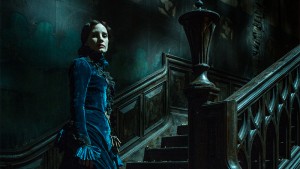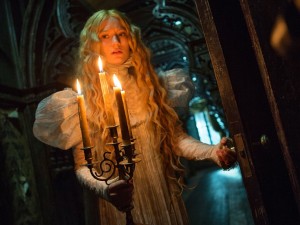Crimson Peak
Crimson Peak, 2015, 1 ½ stars
Crimson puke
Guillermo del Toro’s romantic horror is an embarrassment
Exclusive to MeierMovies, October 16, 2015
Guillermo del Toro has coasted on his reputation as “the visionary director of Pan’s Labyrinth” for nine years. The ride is over.
Sophomoric headline of this review aside, del Toro’s Crimson Peak is not a complete disaster and is certainly not as bad as his last effort, Pacific Rim. As one would expect from this director, it looks superb. But when you include a minor element called the screenplay, it turns into an embarrassment that has more in common with a higher-budget, better-shot Hammer horror (with a dash of Roger Corman) than anything del Toro’s fans have the right to expect after his well-received, though overrated, previous work.
The film, which was written by del Toro and Matthew Robbins, is a Gothic romance – the story of a young woman named Edith (Mia Wisakowska) who is wooed away from her native New York, into the wilderness of rural England by a British gentleman, Sir Thomas Sharpe (Tom Hiddleston), who seems charming enough but has little to his name save his crumbling estate, his odd inventions and his overbearing sister (Jessica Chastain). Only after her arrival at the mansion – named “Crimson Peak” for the blood-red clay it’s built on – does Edith suspect something is amiss spiritually, ethically and familially.
This is not a straightforward ghost story, though it might have been better if it were. Strangely, del Toro makes his heroine a haunted woman – literally – from the film’s start. Both she and we see the ghost of her dead mother early in the film, reducing the fear factor to near zero, despite the CGI scares he piles on later in the pic, which, along with the overlong run time of two hours, make this one of the most overproduced haunted-house tales in cinematic history.
To fully discuss the plot shortcomings and the ridiculously predictable twist – if you can really call it that – would be to spoil the film more than del Toro himself did. Instead, let me just note that when the director completely runs out of ideas in the final act, he turns to a tool he’s used before: graphic violence. Though limited in scope and created with finesse and a certain bloody beauty, the violence is not consistent with the nature of the characters’ relationships and completely upstages what little story there is.
Surprisingly, del Toro never uses the one device that would produce an imaginative death scene: a steam-punkish digging machine that Sir Thomas has invented to extract clay from the ground underneath the mansion and thereby stabilize its foundation – or something like that. The machine’s significance is never fully explained, leading us to believe its real raison d’etre will be to off its creator – just as the clock did to Orson Welles in The Stranger. No such luck.
 Another wasted element is a friendly dog who comes calling when Edith first arrives. However, it soon becomes clear that Thomas and his sister previously discarded the dog and were disappointed and surprised when it returned. But we never really know why. Was the dog digging up some hidden secret like the canine in the aforementioned Welles classic? Does it give solace to lonely Edith? Does it symbolize something greater than itself? No. Its only memorable moment comes when it gets inexplicably smooshed – we assume – toward the end of the film. Though the death happens off screen, thankfully, it’s a startling example of sloppy storytelling and bad taste.
Another wasted element is a friendly dog who comes calling when Edith first arrives. However, it soon becomes clear that Thomas and his sister previously discarded the dog and were disappointed and surprised when it returned. But we never really know why. Was the dog digging up some hidden secret like the canine in the aforementioned Welles classic? Does it give solace to lonely Edith? Does it symbolize something greater than itself? No. Its only memorable moment comes when it gets inexplicably smooshed – we assume – toward the end of the film. Though the death happens off screen, thankfully, it’s a startling example of sloppy storytelling and bad taste.
The three main performances aren’t bad, with Chastain coming as close to rescuing the film as she can. However, Charlie Hunnam, of Sons of Anarchy fame, is totally wasted as a doctor with a mad crush on Edith, and his and Jim Beaver’s performance as Edith’s father are stiff and oddly ineffective. And the lack of chemistry between the performers, combined with the almost tongue-in-cheek lines, reminds one more of Dark Shadows (without the intended comedy) than Gothic horror.
The film contains historical oddities as well. Though it was set in 1901 – as we see when Edith’s father signs a check – everyone is obsessed with candlelight. I suppose investigating spooky sounds in the middle of the night by candelabra is creepier than simply flipping a switch. (Yes, it’s clear that the building has electricity.) Similarly, the plot relies heavily on wax-cylinder sound recordings, one made as early as 1887, though that technology was not perfected for commercial use until 1888. Perhaps the Ghost of Technology’s Future paid them a visit?
Del Toro has said he wanted to challenge our expectations of the genre and even subvert its rules, but that can’t explain his lazy script. Yes, he does play with the typical gender roles to nice effect, but the rest of his experimentations reduce the plot to predictability and preposterousness while turning the ghosts into mere MacGuffins (and unscary ones, at that) or “metaphors for the past,” as we’re spoon fed. Instead of the audience stumbling around in the dark, frightened and anxiously searching for meaning, it’s del Toro who seems blind, like an excited fanboy who wanted to make an homage to The Innocents or The Others – or even to The Orphanage, which he executive-produced – but got lost along the way, further proving that his strengths are art direction, cinematography and producing, not directing or writing.
The movie’s most unintended meta-theatrical moment comes early, when the ghost of Edith’s mother – in a heavy-handed hint of foreshadowing straight out of Scooby-Doo – says, “Beware of Crimson Peak.” It’s too late for the pic’s green-lighters to heed the warning, but it’s not too late for you, dear reader. In fact, the spirit is so spot on in its recommendation that I’d be more than happy to give her a job as my, um, ghostwriter on my next del Toro review so I don’t have to watch the film myself.
© 2015 MeierMovies, LLC
